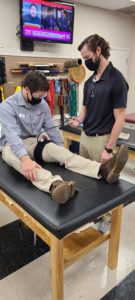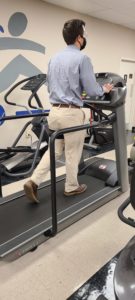
What Is Blood Flow Restriction Training?
It’s not as scary as it sounds! Blood Flow Restriction Training (BFRT) is a specialty treatment program offered at our Forest Acres office in Columbia. BFR is a simple yet powerful technique designed to enhance your workouts and accelerate your fitness journey. Essentially, BFR involves applying specialized pressure to the limbs during exercise, which temporarily restricts blood flow. Before you raise an eyebrow, let’s clarify – this restriction isn’t harmful. It’s carefully controlled and has been shown to trigger a cascade of physiological responses that promote muscle growth, strength gains, and even improved cardiovascular health. So, if you’re curious about how wrapping a band around your arms or legs during a workout can yield impressive results, you’re in the right place. Let’s dive into BFR together!
The History of Blood Flow Restriction
The discovery of this technique occurred quite literally by accident. Dr. Yoshiaki Sato, a young Japanese man, stumbled upon it during a Buddhist ceremony when his legs went numb after prolonged kneeling. Upon massaging his calves for relief, he realized that the numbness stemmed from blood occlusion caused by his seated position. It was in this revelation that Dr. Sato first conceptualized the notion of moderate training with blood flow restriction. He pioneered the original protocols of “Kaatsu,” still practiced in Japan today. After extensive experimentation with various materials like bicycle tubes, bands, and ropes on different body parts, Dr. Sato experienced a breakthrough following an incapacitating ankle and knee injury. Despite doctors’ prognosis of a 6-month healing period, Dr. Sato, utilizing Kaatsu bands, engaged in isometric exercises on his upper leg for 30 seconds, three times daily while wearing a plaster cast. The outcome was remarkable—Dr. Sato achieved a full recovery within six weeks, with no muscle atrophy.
 How does Carolina Physical Therapy utilize Blood Flow Restriction Training?
How does Carolina Physical Therapy utilize Blood Flow Restriction Training?
Here is what we need to know about BFRT as it relates to today’s clinical application and usage. BFRT is based on partial arterial and complete venous occlusion with a pneumatic cuff applied to the muscle that is being trained. Resistance exercises are performed at low intensity (20%-30%) of a 1 repetition maximum. The repetitions are high at 15-30 per set and the time to rest is relatively short at 30 seconds between sets. These factors mimic high intensity training by causing the same type of hormone release, hypoxia, and cell swelling within the muscle at a lower intensity level. The end result is increased muscle hypertrophy without the heavy workload that is traditionally associated with muscle growth.
How can BFRT benefit you?
There are major benefits for patient populations that are in danger of deconditioning and are unable to perform the heavy resistive exercise necessary to maintain muscle mass. With BFRT, a bed restricted cancer patient or a post-op total knee patient can perform low intensity muscle setting exercises and experience hypertrophy without having to do large movements or leave the bed. This will help in eliminating the secondary complications that occur with muscle atrophy and aide in a faster recovery. Patients regain independence quicker and a return to an active lifestyle.

